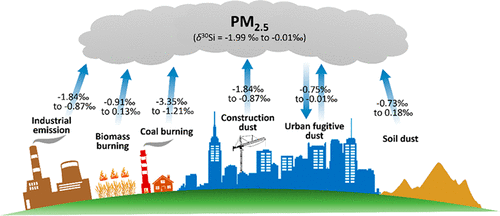当前位置:
X-MOL 学术
›
Environ. Sci. Technol.
›
论文详情
Our official English website, www.x-mol.net, welcomes your feedback! (Note: you will need to create a separate account there.)
Natural Silicon Isotopic Signatures Reveal the Sources of Airborne Fine Particulate Matter
Environmental Science & Technology ( IF 11.4 ) Pub Date : 2018-01-16 00:00:00 , DOI: 10.1021/acs.est.7b06317 Dawei Lu 1, 2 , Qian Liu 1, 2, 3 , Miao Yu 1 , Xuezhi Yang 1, 2 , Qiang Fu 4 , Xiaoshan Zhang 1 , Yujing Mu 1 , Guibin Jiang 1, 2
Environmental Science & Technology ( IF 11.4 ) Pub Date : 2018-01-16 00:00:00 , DOI: 10.1021/acs.est.7b06317 Dawei Lu 1, 2 , Qian Liu 1, 2, 3 , Miao Yu 1 , Xuezhi Yang 1, 2 , Qiang Fu 4 , Xiaoshan Zhang 1 , Yujing Mu 1 , Guibin Jiang 1, 2
Affiliation

|
Airborne particulate pollution is a critical environmental problem affecting human health and sustainable development. Understanding of the sources of aerosol particles is of extreme importance for regional air pollution control. Here we show that natural Si isotopic signature can be used as a new tool to elucidate the sources of fine particulate matter (PM2.5). Through the analysis of Si isotopic composition (δ30Si) of PM2.5 and its primary sources collected in a typical pollution region – Beijing, we recognized the direct source tracing ability of Si isotopes for PM2.5. The different primary sources of PM2.5 had different Si isotopic signatures. The δ30Si value of PM2.5 ranged from −1.99‰ to −0.01‰ and showed a distinct seasonal trend (isotopically lighter in spring/winter and heavier in summer/autumn). The variations in δ30Si of PM2.5 revealed that Si-isotopically light sources were important sources for Beijing’s severe haze pollution and that coal burning was a major cause for the aggregating haze weather in spring/winter in Beijing. We also analyzed several typical haze events by using Si isotopic signatures. As the first study on the natural Si isotopes in the atmospheric environment, this study may reveal an important tool to advance the particulate pollution research and control.
更新日期:2018-01-16



























 京公网安备 11010802027423号
京公网安备 11010802027423号